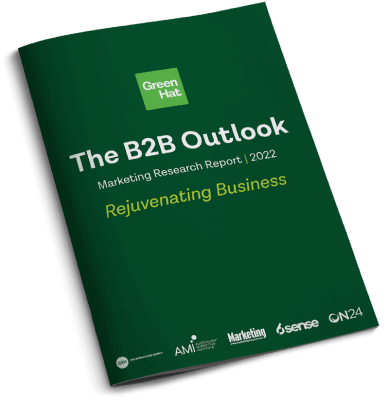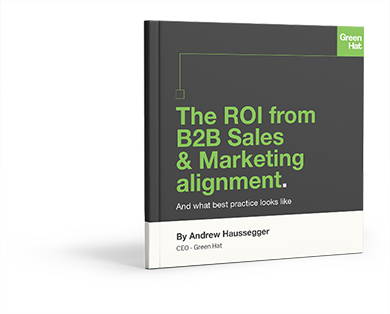How to take your CEO on the journey to build best-in-class marketing
The COVID years had a silver lining for B2B marketers as the traditional sales playing field became an amplified digital landscape. Today, marketing programs leverage advancements such as intent signals, data cleanrooms, and personalisation, amongst many others. If anything, it brought us into the future, faster. The CMO, appointed to add the advanced strategic layer to any marketing function, has a seat at the table and a responsibility to the CEO. It is only fitting then, that the CMO always strives towards a best-in-class (B-I-C) standard. Through our research which included 154 CMOs/Head of Marketing, we know that the pillars of B-I-C are:
- Developing a deep understanding of your customer through personas and/or journey maps
- Having a strategic partnership with sales (and others) and a shared focus on growth
- Measuring and communicating marketing ROI and impact
- Automation of marketing operations
The decisions of B-I-C marketers are 2.5 times less likely to be challenged if they measure marketing performance and 95% of this group reported developments in personas and journey maps have contributed to their marketing success.
More on ‘best-in-class’ for the CMO

We are also observing increasing investment in areas such as brand and value propositions, deeper exploration of the behaviour of target accounts and buying parties, and website personalisation. However, this investment does come with its fetters, as returns are deeply scrutinised and are very much on the CEO’s radar.
Consequently, it’s also the CMO’s head that is first on the chopping block if outcomes don’t meet expectations. This is especially true in today’s economic climate; the State of the CMO reported the average tenure of a CMO in Australia at 29 months, down from 38, arguably the shortest tenure of the C-suite, with CEO’s averaging 60-70 months.
The journey to B-I-C does not happen overnight and executive engagement can be a minefield at times. But based on evidence-driven insights, we’ve developed three mantras for CMOs to consider as you prepare for your next meeting with your CEO.
Be the voice of your customers within the business
One of the most powerful positions a CMO can take to a CEO begins with “From our audience research, we know they prefer….”. For some industries, this means using customer insights to find opportunities for sustainable, practical changes that align with customer values. Elsewhere, it is about striving for better use of touchpoints on the customer journey.
As we see growing investment in this space, the big discussions revolve around customer databases, data cleansing, and management. A lot of the work we see around us can be traced back to either a lack of data or in some circumstances, too much data. If you haven’t already, start with mapping the dots across the customer journey. Find out- where you need measurement and the best way to get relevant metrics. This can take sizeable investment, and ultimately, the support of the CEO.
Mantra #1: “I am the ‘customer champion’ and I will create memorable moments for my audience.”Aligning with internal stakeholders, starting with sales
As part of the leadership team, the CMO will have access and the opportunity to engage with the entire value chain. This becomes a valuable lens into the entire customer journey. Building relationships across the value chain will allow for a deeper understanding of the adjustments that marketing can steer under the guidance of the voice of the customer.
In turn, this places the CMO in a strong position to engage with the CEO on a broader strategic level. Investing in sales and marketing alignment, for example, proves to be a conversation of utmost interest to the CEO as it enables an agreed definition of segments and target accounts that aid in forecasting and critically, revenue.
Mantra #2: “I am clear on what the ideal customer profile is for our business and have aligned with the sales organisation.”The value of sales and marketing alignment

Finding the right MarTech stack
Our final mantra covers two of the pillars of B-I-C: measurement and tech stack. No one needs a reminder about the data breaches of 2022. It’s important to remember as marketers that we are in part responsible for these data honeypots that are so appealing to the criminally inclined. It’s marketers, after all, who have been chasing data points so we can understand our audience better and deliver more powerful experiences. The CEO will be acutely aware of this and as marketers, we must take responsibility and align with the CIO or CISO on the importance of investing in the best security we can.
Alignment with the CIO also enables the right tech stack to provide attribution and data-driven insights – for example, intent data, data augmentation and personalisation. There is also a massive hidden opportunity with 3rd party data. Leveraging the right data can shine a spotlight on accounts that are showing interest in your brand, themes and topics. These data points can feed into your internal workflow, giving a near real-time view of where you stand in the market. When integrated with your ‘revenue tech’ (Revtech) stack, you can translate these insights into real, measurable business opportunities.
Increasingly we are meeting B2B marketers interested in investing in this space, and it is very much an opportunity to enable Sales to get a step ahead of the competition.
While AI and AR/VR are making the headlines, software interoperability is perhaps a much deeper and more influential trend. Having systems that speak to each other seamlessly can make or break the marketing toolkit. Native integrations and increasingly sophisticated APIs have been enabling this for some time, and the CMO should be looking to build up those skills in-house or through a trusted partner.
Mantra #3: “Smart marketing is backed by solid measurement. If you can’t measure it, you can’t prove it.”At the end of 2022, we hosted a webinar discussing the use of Intent Data in account-based marketing. Intent tools such as Bombora are empowering B2B marketers to better understand and target prospects based on their online search behavior. In parallel, platforms such as 6Sense and Terminus are connecting to this data to enable personalised communications with this audience.
In conclusion, by focusing on B-I-C practices, marketers are 2.9x more likely to report strong returns, in a world where on average, only 40% of B2B marketers achieved their marketing objectives in 2021. Today’s CMO needs to be focused on engaging the entire value chain, embodying the voice of customers, and critically, empowering the CEO with data storytelling. By owning this complete narrative, the CMO will be in a strong position to guide the CEO to where marketing investment should be directed.

 Marketing Automation
Marketing Automation ABM
ABM Brand
Brand Strategy
Strategy Creative & Content
Creative & Content





